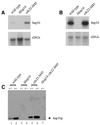Expression of hsp16 in response to nucleotide depletion is regulated via the spc1 MAPK pathway in Schizosaccharomyces pombe
- PMID: 11452028
- PMCID: PMC55794
- DOI: 10.1093/nar/29.14.3030
Expression of hsp16 in response to nucleotide depletion is regulated via the spc1 MAPK pathway in Schizosaccharomyces pombe
Abstract
A universal response to elevated temperature and other forms of physiological stress is the induction of heat shock proteins (HSPs). Hsp16 in Schizosaccharomyces pombe encodes a polypeptide of predicted molecular weight 16 kDa that belongs to the HSP20/alpha-crystallin family whose members range in size from 12 to 43 kDa. Heat shock treatment increases expression of the hsp16 gene by 64-fold in wild-type cells and 141-fold in cdc22-M45 (ribonucleotide reductase) mutant cells. Hsp16 expression is mediated by the spc1 MAPK signaling pathway through the transcription factor atf1 and in addition through the HSF pathway. Nucleotide depletion or DNA damage as occurs in cdc22-M45 mutant cells, or during hydroxyurea or camptothecin treatment, is sufficient to activate hsp16 expression through atf1. Our findings suggest a novel role for small HSPs in the stress response following nucleotide depletion and DNA damage. This extends the types of damage that are sensed by the spc1 MAPK pathway via atf1.
Figures





References
-
- DeJong W.W., Leunissan,J.A.M. and Voorter,C.E.M. (1993) Evolution of the α-crystallin/small heat shock protein family. Mol. Biol. Evol., 10, 103–126. - PubMed
-
- Carver, J.A. (1999) Probing the structure and interactions of crystallin proteins by NMR spectroscopy. Prog. Retin. Eye Res., 18, 431–462. - PubMed
-
- Boelens W.C., Croes,Y., deRuwe,M., deReu,L. and deJong,W.W. (1998) Negative charges in the C-terminal domain stabilize the αβ-crystallin complex. J. Biol. Chem., 273, 28085–28090. - PubMed
-
- Kim K.K., Kim,R. and Kim,S.H. (1998) Crystal structure of a small heat shock protein. Nature, 394, 595–599. - PubMed
-
- Arrigo A.-P. and Landry,J. (1994) Expression and function of the low-molecular weight heat shock proteins. In Morimoto,R., Tissieres,H. and Georgeopoulos,C. (eds), The Biology of Heat Shock Proteins and Molecular Chaperones. Cold Spring Harbor Laboratory Press, Cold Spring Harbor, NY. pp. 335–373.
Publication types
MeSH terms
Substances
LinkOut - more resources
Full Text Sources
Other Literature Sources
Molecular Biology Databases

